..
CHAPTER 1: INTRODUCTION -
THE FUNGI AND FUNGAL ACTIVITIES
This chapter covers the following
major topics:
The place of fungi in the "Tree of
Life" - setting the scene
The
characteristic features of fungi: defining the fungal
kingdom
The major activities of fungi as parasites, symbionts and
saprotrophs
Fungal
biotechnology

SAMPLE
TEXT:
Fungi are a
unique group of organisms, different from all others in
their behaviour and cellular organisation. Fungi also
have an enormous range of activities - as pathogens
of crop plants or humans, as decomposer
organisms, as experimental ‘model
organisms’ for investigating genetics and
cell biology, and as producers of many important
metabolites. The uniqueness of fungi is a
prominent feature of this book, which adopts a functional
approach, focusing on topics of inherent interest and
broad significance in fungal biology. The uniqueness of
fungi is reflected in the fact that have the status of a Kingdom,
equivalent to the plant and animal Kingdoms. So, fungi
represent one of the three major evolutionary branches of
multicellular organisms.
In terms
of biodiversity, there are estimated to be at least 1.5
million different species of fungi, but only about
75,000 species (about 5% of the total) have been
described to date. For comparison, there are estimated to
be 4.9 million arthropod species and about 420,000 seed
plants (Hawksworth, 2001, 2002). If the estimate of the
number of fungal species is even remotely accurate then
we still have much to learn, because even the fungi that
we know about play many important roles. To set the
scene, we can mention just a few examples.
Fungi
are the most important causes of crop
diseases, responsible for billions of pounds
worth of damage each year, and for periodic
devastating disease epidemics.
Fungi
are the main decomposers and recyclers of organic
matter, including the degradation of
cellulose and wood by the specialised enzyme
systems unique to fungi.Fungi produce some of the
most toxic known metabolites, including the carcinogenic
aflatoxins and other mycotoxins in
human foods and animal feedstuffs.
With
the advance of AIDS and the increasing role of
transplant surgery, fungi are becoming
one of the most significant causes of death of
immunocompromised and immunosuppressed patients.
Fungal diseases that were once extremely rare are
now commonplace in this sector of the population.
Fungi
have an enormous range of biochemical activities
that are exploited commercially –
notably the production of antibiotics (e.g. penicillins),
steroids (for contraceptives), cyclosporins
(used as immunosuppressants in transplant
surgery), and enzymes for food processing and for
the soft drinks industry.
Fungi
are major sources of food. They
are used for bread-making, for mushroom
production, for several traditional fermented
foods, for production of Quorn™ mycoprotein
– now widely available in supermarkets and
the only survivor of the many “single-cell
protein” ventures of the late 1900s. And, of
course, for the production of alcoholic drinks.
Fungi
can be used as ‘cellular factories’ for
producing heterologous (foreign) gene
products. The first genetically engineered
vaccine approved for human use was produced by
engineering the gene for hepatitis B surface
antigen into the yeast (Saccharomyces
cerevisiae) genome. In this way the antigen
can be produced and exported from the cells, then
purified from the growth medium.
The genome
sequences of several fungi have now been
determined, and in several cases the
genes of fungi are found to be homologous
(equivalent) to the genes of humans. So,
fungi can be used to investigate many fundamental
cell-biological processes, including the control
of cell division and differentiation relevant to
biomedical research.
Fungi
are increasingly being used as commercial biological
control agents, providing alternatives to
chemical pesticides for combating insect pests,
nematodes and plant-pathogenic fungi.
The first
part of this book deals with the growth, physiology,
behaviour, genetics and molecular genetics of fungi,
including the roles of fungi in biotechnology. This part
also includes an overview of the main fungal groups
(Chapter 2). The second part covers the many ecological
activities of fungi – as decomposers of organic
matter, as spoilage agents, as plant pathogens, plant
symbionts, and as pathogens of humans. A final chapter is
devoted to the ways of preventing and controlling fungal
growth, because this presents a major challenge in modern
Fungal Biology.
Images from
Chapter 1. Click on the thumbnails for a larger
image
NOTE: some images (shown as WWW) link you
directly to a remote website
|

Fig. 1.1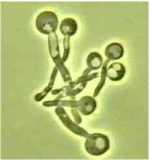
Fig. 1.4b
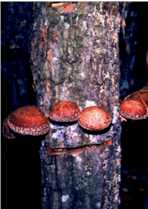
Fig. 1.7b (see www)
|
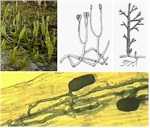
Fig. 1.2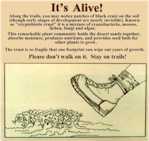
Fig. 1.5
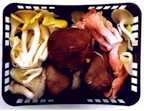
Fig. 1.8a
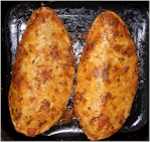
Fig. 1.9b
|
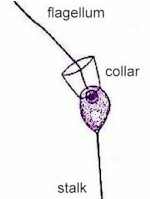
Fig. 1.3 (see
www)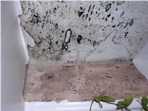
Fig. 1.6

Fig.1.8b

Fig. 1.10
|
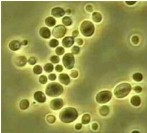
Fig. 1.4a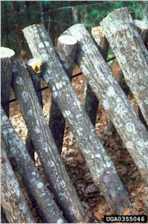
Fig. 1.7a (see www)
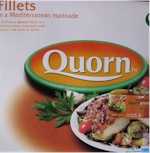
Fig. 1.9a
|
Table 1.1
Comparison of some features of fungi, animals and
plants
Note
that, in many respects, the fungi are more
similar to animals than to plants
|
Character
|
Fungi
|
Animals
|
Plants
|
| Growth habit |
Hyphal tip growth or
budding yeasts |
Not hyphal |
Multicellular tissues |
| Nutrition |
Heterotrophic, absorb
soluble nutrients |
Heterotrophic, ingest food |
Photosynthetic |
| Cell wall |
Typically contains chitin |
Wall absent, but chitin is
found in insect exoskeletons |
Cellulosic |
| Nuclei |
Usually haploid; nuclear
membrane persists during division |
Typically diploid; the
membrane breaks down during nuclear division |
Diploid; the membrane
breaks down during nuclear division |
| Histones |
Histone 2B |
Histone 2B |
Plant histones |
| Microtubules |
Sensitive to benzimidazoles
and griseofulvin |
Sensitive to colchicine |
Sensitive to colchicine |
| Lysine synthesis |
Synthesised by AAA pathway |
Not synthesised, must be
supplied |
Synthesised by DAP pathway |
| Golgi cisternae |
Unstacked, tubular |
Stacked, plate-like |
Stacked, plate-like |
| Mitochondria |
Plate- or disc-like
cisternae |
Plate- or disc-like
cisternae |
Tubular cisternae |
| Translocated
carbohydrates |
Polyols (mannitol,
arabitol, etc.), trehalose |
Trehalose in insects |
Glucose, fructose, sucrose |
| Storage compounds |
Glycogen, lipids, trehalose
|
Glycogen, lipids, trehalose
in some |
Starch |
| Mitochondrial codon
usage |
UGA codes for tryptophan |
UGA codes for tryptophan |
UGA codes for chain
termination |
| Membrane sterols |
Ergosterol |
Cholesterol |
Sitosterol and other plant
sterols |
................................
Table 1.2 Nutritional composition
of Quorn™ mycoprotein
compared with traditional protein sources [Data
from Trinci, 1992]
|
| ........ |
Units
|
Quorn
|
Cheddar cheese
|
Raw chicken
|
Raw lean beef
|
Fresh cod
|
Protein
|
g 100g-1
|
12.2
|
26.0
|
20.5
|
20.3
|
17.4
|
Dietary fibre
|
g 100 g-1
|
5.1
|
0
|
0
|
0
|
0
|
Total fats
|
g 100 g-1
|
2.9
|
33.5
|
4.3
|
4.6
|
0.7
|
Fat ratio
|
Polyunsaturated: saturated
|
2.5
|
0.2
|
0.5
|
0.1
|
2.2
|
Cholesterol
|
mg 100g-1
|
0
|
70
|
69
|
59
|
50
|
Energy
|
kJ 100g-1
|
334
|
1697
|
506
|
514
|
318
|
..........................
Table 1.3. Some valuable
secondary metabolites produced commercially from
fungi
|
Metabolite
|
Fungal source
|
Application
|
| Penicillins |
Penicillium
chrysogenum |
Antibacterials
|
| Cephalosporins |
Acremonium
chrysogenum |
Antibacterials
|
| Griseofulvin |
Penicillium
griseofulvum |
Antifungal
|
| Fusidin |
Fusidium
coccineum |
Antibacterial
|
| Cyclosporins |
Tolypocladium
spp. |
Immunosuppressants
|
| Zearalenone |
Gibberella zeae |
Cattle growth
promoter
|
| Gibberellins |
Gibberella
fujikuroi |
Plant hormone
|
| Ergot alkaloids and
related compounds |
Claviceps
purpurea and related fungi |
Many effects
including: antimigraine, vasoconstriction,
vasodilation, antihypertension, anti-Parkinson,
psychiatric disorders |
..............................
Table 1.4. Some enzymes produced
commercially from fungi
|
Enzyme
|
Fungal source |
Application |
alpha-amylase |
Aspergillus niger, A. oryzae |
Starch conversions |
Amyloglucosidase |
A. niger |
Starch syrups, dextrose foods |
Pullulanase |
Aureobasidium pullulans |
Debranching of starch |
Glucose aerohydrogenase |
A. niger |
Production of gluconic acid |
Proteases (acid, neutral, alkaline) |
Aspergillus spp. etc. |
Breakdown of proteins (baking, brewing, etc.) |
Invertase |
Yeasts |
Sucrose conversions |
Pectinases |
Aspergillus, Rhizopus |
Clarifying fruit juices |
Rennet |
Mucor spp. |
Milk coagulation |
Glucose isomerase |
Mucor, Aspergillus |
High fructose syrups |
Lipases |
Mucor, Aspergillus, Penicillium |
Dairy industry, detergents |
Hemicellulase |
A. niger |
Baking, gums |
Glucose oxidase |
A. niger |
Food processing |
GO TO
CHAPTER 2 ?
GO TO
HOME PAGE ?
|














